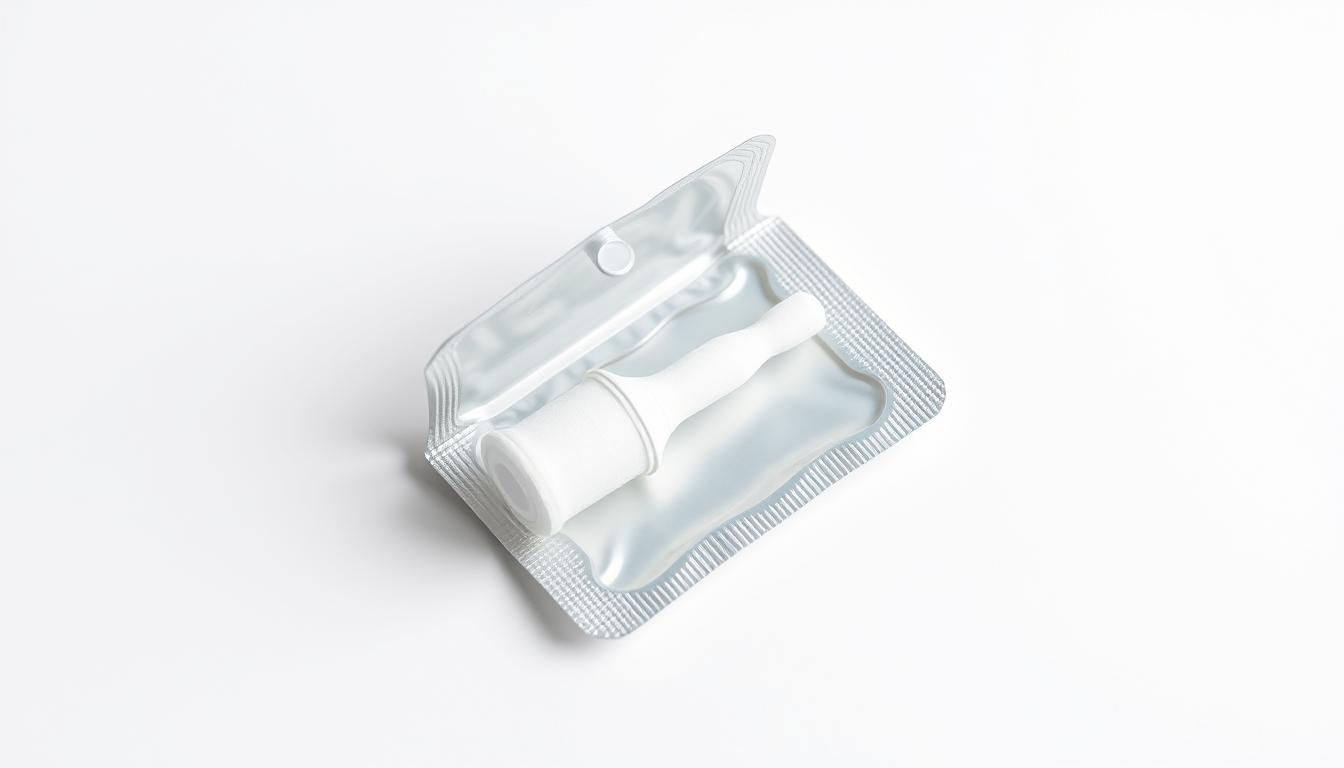ACDF surgery can change lives for those with neck pain and spinal issues. Knowing how long to wear a cervical collar is key for a smooth recovery.
Your healing starts right after surgery. The cervical collar is vital, keeping your neck safe and stable during the early healing stages.
Many patients wonder about their care after surgery. How long you wear a cervical collar depends on your health, the surgery, and your doctor’s advice. This guide will help you understand cervical collar use, making your recovery easier.
Using your collar correctly is more than just following rules. It’s about helping your body heal well. Knowing about post-surgery care lets you help your recovery and avoid problems.
Key Takeaways
- Cervical collars are essential for stabilizing the neck after ACDF surgery
- Wear time varies based on individual patient needs
- Proper collar usage supports optimal healing
- Regular communication with your healthcare provider is critical
- Patient compliance significantly impacts recovery outcomes
Understanding ACDF Surgery and Its Purpose
Anterior Cervical Discectomy and Fusion (ACDF) surgery is a key treatment for neck and spine problems. It’s designed for those with severe discomfort and limited movement. Our team focuses on specific spinal issues that cause a lot of pain.
During ACDF surgery, we remove damaged discs from the neck and fuse the area. This helps fix many spinal problems. It also sets the stage for a detailed recovery plan.
Conditions Addressed by ACDF
Our team treats several serious spinal conditions with ACDF, including:
- Herniated cervical discs
- Cervical spondylosis
- Degenerative disc disease
- Spinal cord compression
- Chronic neck pain with neurological symptoms
Benefits of Surgical Intervention
ACDF surgery brings many benefits for patients with complex spinal issues. These advantages include:
- Significant pain reduction
- Improved neurological function
- Enhanced mobility
- Minimally invasive approach
- Long-term structural spine stability
Success Rates and Patient Outcomes
Studies show great results for ACDF surgery recovery. About 80-90% of patients see a big drop in pain and better function. This success is thanks to careful patient choice and precise surgery.
We’re dedicated to giving our patients the best care for a full recovery. Our advanced surgical methods help keep your spine healthy for the long term.
The Importance of Cervical Collars in Post-ACDF Recovery
Cervical collars are key in healing after ACDF surgery. These neck braces are vital for recovery. They offer support and stability to the surgical area.
Wearing a neck brace after ACDF surgery has many benefits:
- Maintains proper neck alignment and reduces strain on surgical areas
- Prevents excessive movement that could compromise fusion
- Supports healing of vertebral structures
- Minimizes possible complications during early recovery stages
Surgeons recommend cervical collars as a primary method of protecting the delicate surgical site. These devices help patients limit neck movements. This allows the fusion process to go smoothly and lowers the risk of setbacks.
The biomechanical support from cervical collars is essential. They limit rotation, flexion, and extension. These movements could harm the healing process. By controlling these, patients can have a more controlled and predictable recovery.
It’s important for patients to know that using cervical collars is not just a suggestion. It’s a critical part of successful recovery after surgery. Using these neck braces correctly helps in achieving the best healing results and long-term success.
How Long Do You Wear a Cervical Collar After ACDF Surgery
Knowing how long to wear a cervical collar after ACDF surgery is key for a smooth recovery. The time frame depends on several important factors. These factors affect how well you heal and how well the surgery works.
Most people need to wear a cervical collar for a few weeks to help their spine heal right. The time can be between 4 to 6 weeks. But, some cases might need a different plan.
Standard Wear Time Guidelines
- Typical cervical collar duration: 4-6 weeks
- Minimum recommended wear time: 2-3 weeks
- Maximum recommended wear time: 8 weeks in complex cases
Factors Affecting Wear Duration
Several key things can change how long you need to wear a cervical collar after ACDF surgery:
- Number of vertebrae fused
- Patient’s overall health condition
- Surgical complexity
- Individual healing rate
Physician-Specific Recommendations
Every patient’s recovery is different. Doctors give advice based on how each person is healing and the details of their surgery.
| Patient Factors | Typical Collar Duration |
|---|---|
| Single-level fusion | 4-6 weeks |
| Multi-level fusion | 6-8 weeks |
| Complicated surgical cases | 8-12 weeks |
It’s important for patients to talk often with their doctors. This helps figure out the right time to wear a cervical collar after ACDF surgery. Regular check-ups are also key. They help see how well you’re healing and adjust your recovery plan if needed.
Types of Cervical Collars Used After ACDF
Choosing the right cervical collar is key after ACDF surgery. It helps with healing and comfort. There are many options for each patient’s needs.
- Soft Collars: Lightweight and flexible, these provide minimal support during the initial stages of recovery after ACDF surgery
- Semi-Rigid Collars: Offer moderate support with adjustable features for enhanced comfort
- Rigid Collars: Provide maximum stabilization for patients requiring extensive neck immobilization
Soft collars are best for simple surgeries. They let you move a bit but keep your neck straight. They’re good for early recovery.
Semi-rigid collars offer more support but are comfy. They have adjustable straps and moldable parts. This makes them fit your body for better healing.
Rigid collars give the most support. They’re for those needing to keep their neck very stable. They stop all movement for the best healing.
Your doctor will pick the best collar for you. They consider your surgery, how you’re healing, and what you need for recovery.
Initial Post-Surgery Period: First Week of Collar Usage
After ACDF surgery, the first week is critical. Our tips help you adjust to wearing a cervical collar. They aim to reduce pain and support healing during your recovery.
Managing Daily Activities
Recovery means changing how you do daily tasks. Here are some tips:
- Prepare meals in advance that are easy to eat while wearing a cervical collar
- Use grab bars and supportive devices for bathing and dressing
- Ask family members for assistance with household chores
- Wear loose, comfortable clothing that doesn’t restrict collar movement
Sleep Adaptations
Getting good sleep is key to recovery. Recommended sleep strategies include:
- Use multiple pillows to support neck and head alignment
- Sleep in a slightly elevated position
- Avoid sleeping on your stomach
- Consider a recliner chair for initial nights post-surgery
Pain Management Strategies
Managing pain is important for a smooth recovery. Patients should:
- Follow prescribed medication schedules precisely
- Apply ice or heat as recommended by their surgeon
- Practice gentle, approved stretching techniques
- Communicate any significant pain changes with medical professionals
Every recovery is different. Be patient, follow your doctor’s advice, and stay in touch with your healthcare team. This will help you recover well.
Proper Cervical Collar Fitting and Adjustment
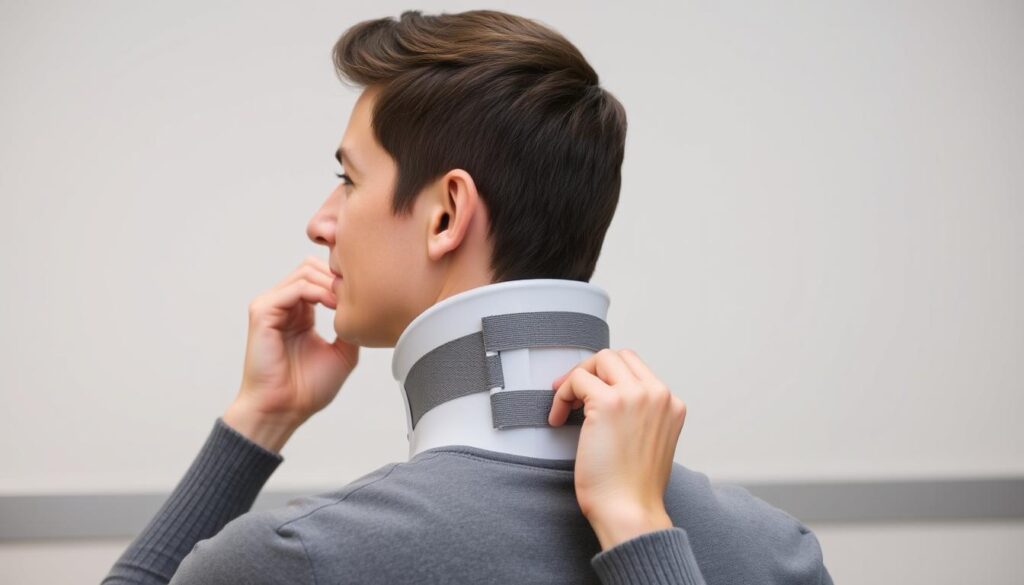
Wearing a neck brace after ACDF surgery is important. It needs to fit right to support your neck and help it heal. A good fit is key for a smooth recovery.
To get the right fit, follow some important steps. The collar should support your neck well but also be comfy for everyday use.
- Measure neck circumference precisely
- Ensure collar height covers cervical vertebrae
- Check for snug but not overly tight fit
- Verify no gaps between collar and skin
It’s vital to work with your healthcare team to get your collar just right. They can help make sure you get the best support and avoid any problems during your recovery.
| Fitting Aspect | Correct Approach | Potential Issues |
|---|---|---|
| Strap Tension | Snug but allows finger insertion | Too loose or restrictive movement |
| Vertical Positioning | Chin supported, neck aligned | Improper neck angle |
| Comfort Level | Minimal skin irritation | Pressure points or chafing |
Adjusting your neck brace regularly is a must. Make sure to check its fit every day. If it’s uncomfortable, tell your doctor right away.
- Inspect for wear and tear
- Clean collar regularly
- Adjust for swelling or weight changes
Getting your cervical collar to fit right helps your body heal naturally. It keeps your neck stable during the important recovery time after ACDF surgery.
Signs of Proper Healing During Collar Use
Understanding the healing process after ACDF surgery is key. Each person’s recovery is different. Knowing the signs of healing helps patients feel more confident.
Your body tells you how it’s healing through different signs. Spotting these signals helps you stay on track with your recovery.
Expected Recovery Milestones
The recovery from ACDF surgery usually follows a set path. Important milestones include:
- Reduced neck and arm pain within 2-4 weeks
- Gradual improvement in neck mobility
- Decreased reliance on pain medications
- Improved sleep quality
- Increased ability to perform daily activities
Warning Signs to Watch For
While healing, it’s important to watch out for warning signs. Some critical ones are:
| Warning Sign | Potential Indication | Recommended Action |
|---|---|---|
| Persistent severe pain | Possible infection or nerve compression | Contact surgeon immediately |
| Numbness or weakness | Potential nerve issues | Seek medical evaluation |
| Fever over 101°F | Possible surgical site infection | Urgent medical attention required |
| Increased swelling | Potential healing complications | Consult healthcare provider |
Remember, each patient’s recovery from ACDF surgery is unique. Keeping in touch with your healthcare team is vital during this time.
Managing Personal Hygiene While Wearing a Collar
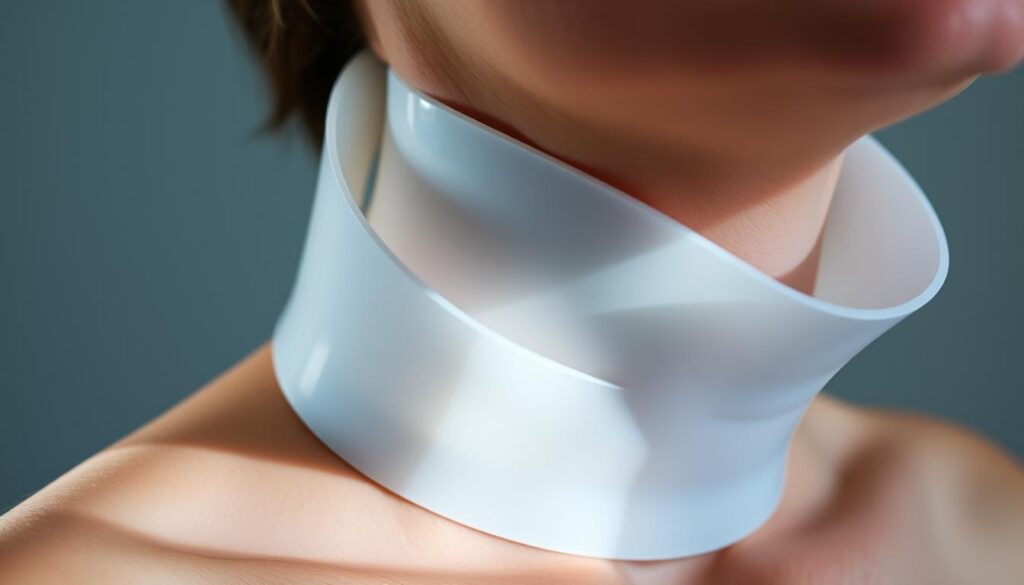
Keeping clean after acdf surgery can be tough with a cervical collar. Our guide offers practical tips for this important recovery time.
It’s vital to stay clean while wearing a collar. Patients must focus on skin health and overall cleanliness after acdf surgery.
- Use gentle, hypoallergenic cleansing wipes for daily surface cleaning
- Keep a small towel handy to absorb excess moisture
- Dry the skin thoroughly under the collar to prevent irritation
- Use talcum-free powder to reduce friction and moisture
Pro tip: Always check with your healthcare provider before cleaning your collar.
Bathing with a cervical collar requires extra care. Here are some tips:
- Ask a family member to assist you during bathing
- Use a handheld shower head for targeted cleaning
- Avoid getting the collar wet
- Pat dry carefully around the collar edges
Preventing skin issues is key. Look out for signs of irritation, redness, or infection. Your medical team can offer advice specific to your needs.
Physical Therapy and Collar Usage Timeline
The recovery after ACDF surgery needs a well-planned physical therapy approach. Patients go through a healing process that includes gentle movement and building strength.
Going through physical therapy after ACDF surgery takes time and the right guidance. We suggest using gentle, step-by-step methods. These help keep the neck stable and muscles strong.
Recommended Exercises
During the recovery, patients can do certain low-impact exercises. These keep the neck moving without hurting the healing process:
- Gentle neck rotation exercises while wearing the cervical collar
- Shoulder blade squeezes to maintain upper body strength
- Seated isometric neck exercises
- Breathing techniques to reduce muscle tension
Activity Modifications
To protect the surgical area, patients need to make some changes in their activities. They should:
- Avoid lifting objects heavier than 5 pounds
- Use ergonomic support when sitting
- Practice proper posture during recovery
- Follow physical therapist’s specific guidelines
Always talk to a professional physical therapist. They can make your recovery plan safe and effective after ACDF surgery.
Transitioning Out of Your Cervical Collar
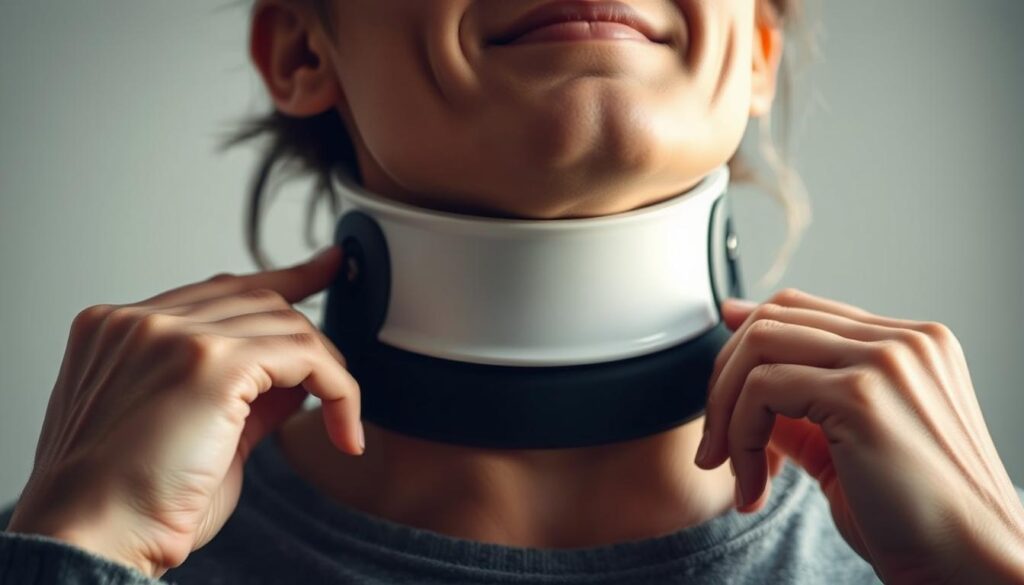
Getting out of your cervical collar is a big step in your recovery. It usually starts 4-6 weeks after surgery. This step needs patience and careful watching by your doctor.
Your doctor will make a plan just for you. They’ll look at how well you’re healing. They’ll check your neck muscles, how well you can move, your pain, and how stable your healing is.
Getting off the collar is done in steps. You’ll start by taking it off for a little while during certain activities. Then, you’ll slowly move more and more under your doctor’s watch.
| Recovery Stage | Collar Usage | Activity Level |
|---|---|---|
| Initial Transition | Intermittent removal | Limited, supervised movements |
| Mid Transition | Reduced wear time | Increased gentle activities |
| Final Stage | Complete removal | Normal daily activities |
Warning signs that might indicate the need for continued collar use include persistent pain, instability, or reduced neck strength. Always talk to your surgeon during this time. They can help you heal safely and well.
Physical therapy is key in getting your neck back to normal. They’ll help you build muscle and get your neck flexible again. This makes the process easier and less painful.
Common Complications from Improper Collar Use
When you’re recovering from ACDF surgery, it’s key to watch out for problems caused by wearing the cervical collar wrong. Knowing these risks helps keep your healing on track and avoids long-term health problems.
People who have ACDF surgery need to be aware of the issues that can come from wearing the cervical collar. Using it wrong can lead to serious health issues that might harm your surgery’s success.
Skin Issues and Prevention
Skin problems are common during ACDF surgery recovery. You might face:
- Pressure sores from wearing it too long
- Skin irritation and rashes
- Fungal infections in moist areas
To avoid these issues, you can:
- Keep your skin clean and dry
- Use soft, breathable padding
- Check your skin daily for signs of irritation
Muscle Weakness Concerns
Long-term use of the cervical collar can cause muscle weakness and atrophy. You might experience:
- Reduced neck muscle strength
- Less range of motion
- Potential long-term stiffness
Doctors suggest gentle exercises and adjusting the collar as needed to prevent muscle loss. It’s important to talk to your healthcare team throughout your recovery.
Long-term Recovery Expectations
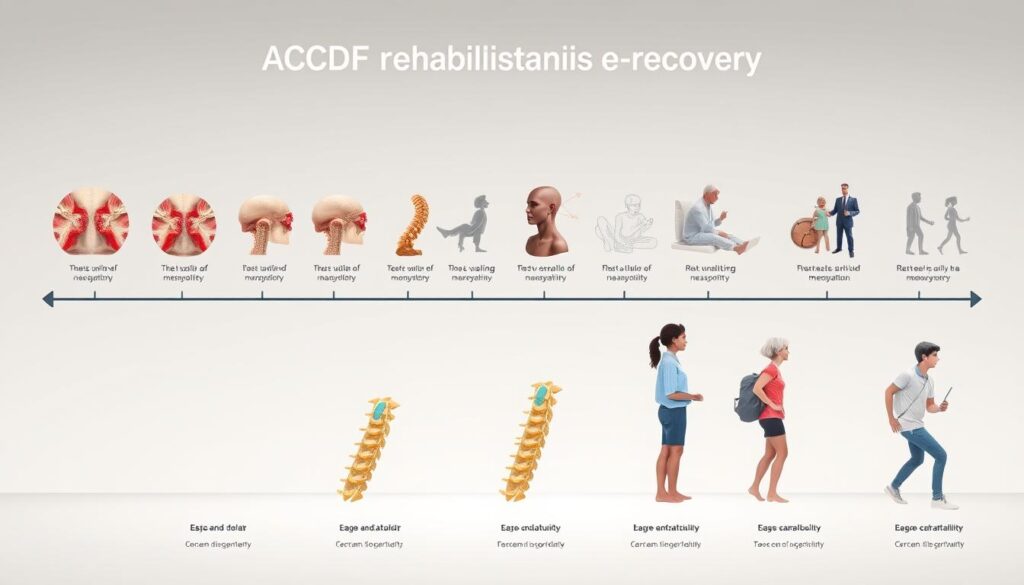
The recovery from ACDF surgery goes beyond the first healing phase. Patients will see their neck function and mobility improve over time. Our guide helps you understand what to expect over 3 to 6 months post-surgery.
Important parts of long-term recovery include:
- Gradual decrease in neck pain and stiffness
- Improved range of motion
- Strengthening of neck and shoulder muscles
- Adaptive lifestyle changes
Patients hit major milestones in their recovery. The first three months are vital for healing and getting back to normal. Most people see big improvements in their daily life and pain levels during this time.
| Recovery Phase | Expected Outcomes | Duration |
|---|---|---|
| Initial Recovery | Reduced pain, limited mobility | 0-6 weeks |
| Mid-Term Recovery | Increased mobility, reduced restrictions | 6-12 weeks |
| Long-Term Recovery | Near-full function, minimal discomfort | 3-6 months |
Physical therapy is key to a full recovery. It’s important to work with healthcare experts to create a rehab plan that fits your needs. This plan should reflect your healing progress and specific recovery goals.
Some patients may see continued improvements for up to a year after ACDF surgery. Staying positive, following doctor’s orders, and sticking to rehab exercises are essential for the best long-term results.
Returning to Daily Activities Post-Collar Removal
The acdf surgery rehabilitation period is a big step for patients. It means they can start going back to their normal lives. After weeks of recovery, taking off the cervical collar opens up new chances to do daily activities.
Getting past the collar phase needs careful planning. It’s important to think about work and physical activities. Patients should be patient and listen to their body’s healing.
Workplace Reintegration Strategies
Going back to work after surgery needs a smart plan. Jobs vary, so each one has its own needs:
- Desk jobs: Start slow with ergonomic changes
- Physical labor: Do modified tasks and follow rules
- Flexible hours help in the early recovery
Exercise and Physical Activity Guidelines
Building strength after surgery is a slow process:
- Begin with simple stretching
- Get a plan from a physical therapist
- Slowly add more intense activities
| Activity Level | Recommended Actions | Duration |
|---|---|---|
| Week 1-2 Post-Collar | Light walking, gentle neck movements | 15-20 minutes daily |
| Week 3-4 Post-Collar | Low-impact strength training | 30 minutes, 3x weekly |
| Week 5-6 Post-Collar | Progressive resistance exercises | 45 minutes, 4x weekly |
Remember: Listen to your body and never push beyond recommended limits during recovery.
When Additional Collar Time May Be Needed
Understanding how long to wear a cervical collar after ACDF surgery can be tricky. Some people might need to wear it longer than usual because of their health.
Doctors might tell you to wear the collar longer in certain situations:
- Multiple level spinal fusion procedures
- Slower bone healing processes
- Complex surgical interventions
- Individual patient recovery characteristics
How long you need to wear the collar depends on how well your body heals. People with health issues like diabetes or osteoporosis might heal slower. This means they might need to wear the collar for longer.
Signs that you might need to wear the collar longer include:
- Persistent neck instability
- Incomplete vertebral fusion
- Ongoing pain or discomfort
- Radiographic evidence of slow healing
Our medical team keeps a close eye on how you’re healing. They adjust how long you wear the collar based on your needs. Regular check-ups help figure out the best time to stop wearing it.
While it might seem hard to wear the collar for a long time, it’s very important. It helps make sure you heal well and avoid any problems.
Professional Support During Recovery
Recovering from ACDF surgery needs a strong support team of healthcare experts. Our team knows that good care after ACDF surgery is more than just following rules. It’s about working closely with your medical team.
Your healing path will involve many healthcare experts. Each one is important for your recovery. You’ll meet:
- Neurosurgeons who did the ACDF surgery
- Orthopedic specialists checking on you
- Physical therapists creating rehab plans
- Occupational therapists helping with daily tasks
Regular visits with your healthcare team are vital. They help track your healing. At these meetings, your team will:
- Check how the surgery site is healing
- Look at your neck’s movement
- Change your pain treatment if needed
- Give you specific advice for recovery
Good communication is essential for a smooth recovery. Always feel free to ask questions or share worries. Your medical team aims to help you get the best results and support during your recovery.
Every patient’s healing is different. Your healthcare team will make a care plan just for you. This ensures you get the right support as you recover from ACDF surgery.
Conclusion
Knowing how long to wear a cervical collar after ACDF surgery is key for healing. Most people wear it for 4-6 weeks. It’s important to follow your surgeon’s advice and listen to your body.
Using a cervical collar correctly helps stabilize your neck and protects the surgery area. Stay committed to your recovery plan. Each step you take brings you closer to being active again.
Recovering from ACDF surgery can be tough, but many people do it successfully. Wearing the collar as told, going to follow-up visits, and doing physical therapy helps a lot. With the right care, you can improve your neck’s function and feel less pain.
Your effort to understand cervical collar use shows you care about your health. Trust your doctors, stay positive, and work towards getting back to full strength.




